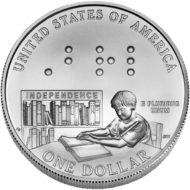It seems that we have heard more about accessible currency this year than in any year before. If we read the news carefully, there is announcement almost every month somewhere about making currency more accessible, or maintaining the commitment. I will give a brief overview of what happened this year. As I explained in an earlier post, finding this type of information is not always obvious, and it is possible I missed a few items. If you are aware of any, please leave a comment at the bottom and I will add it.
A big thank you to my friend Quentin Christensen for helping me verifying the new features from pictures on the internet and in catalogs.
